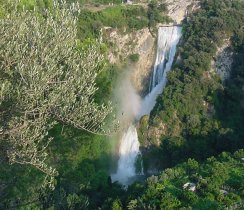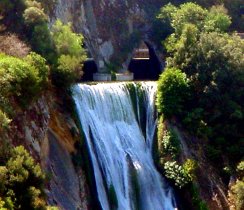In 105 a. C., the flood was very serious, as Plinius the Young hand down, just like another very catastrophic one that occurred in 1826, when many buildings were swept away from the fury of the waters and many people lost their lives. Something that should be also taken into consideration is the particular geological configuration of the lsoil in the area of Tivoli, made up with a not compacted travertine or rather calc-tufa, with the presence of many caves and natural channels. This makes the soil like a "sponge" absorbing water along the course of the Aniene and then releasing it into the valley, creating, other than the mentioned waterfall, also a fantastic setting of little cascades, no more visible today because of the interruption of the natural feeding of the hydro geological system. Probably, they decided to operate to divert the river bed, more for political reasons (to more impose the pontifical power on the city) than to face new disastrous inundations.
Matter of fact, the drafting of the projects were given world resonance, so much that many foreign architects took part in the competition with their works. Almost all of the twenty-three projects submitted proposed the construction of massive walls and banks, diverting the possible floods towards out-flowing streams, until Clemente Folchi planned to pierce Mount Catillo.
The Gregorian drifts (underground passages), 280 mts. long and with a variable length of 10 mts. at the entrance and 7,20 mts. at the exit, pulled the river away, and took the danger away from Tivoli, also because with the diverting of the waters, the level of the river was reactivated towards the five channels that fed many industrial firms with water. On the 9th of June 1832, Gregory XVI signed the order of execution of the works that were not limited only to the diverting of the river but also permitted the construction of two big squares ("Piazza Rivarola" and "Piazza Massimo"), both united by the solid and elegant Gregorian Bridge, that was destroyed during the 1944 bombing and then rebuilt. The whole cost, calculated to be 284.000 scuds, was paid for 3/10 by public money; for an half by the State tax-payers, by establishing an additional tax of one cent on the "dativa" over the rural land office survey and finally for 2/10 by the Community of Tivoli. The project was finished in less than two years, starting from the 6th of July 1832. The official inauguration took place on the 7th of October 1835: Pope Gregory XVI, watched the extraordinary drop of the artificial Gregorian Fall so called using the same name of the bridge and the villa, from a place called "the throne".






